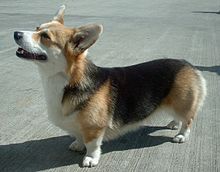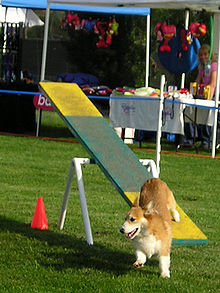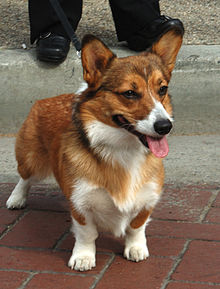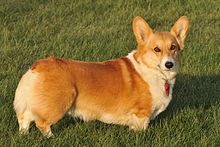- Pembroke Welsh Corgi
-
Pembroke Welsh Corgi 
Tri-Color Pembroke Welsh Corgi Nicknames Pembroke, PWC, Pem, corgi Country of origin Wales, United Kingdom Traits Classification and standards FCI Group 1 Section 8 #39 standard AKC Herding standard ANKC Group 5 (Working Dogs) standard CKC Group 7 - Herding Dogs standard KC (UK) Pastoral standard NZKC Working standard UKC Herding Dog Breeds standard Dog (Canis lupus familiaris) The Pembroke Welsh Corgi (
 /ˈkɔrɡi/) is a herding dog breed, which originated in Pembrokeshire, Wales. It is one of two breeds known as Welsh Corgi: the other is the Cardigan Welsh Corgi. The corgi is one of the smallest dogs in the Herding Group. Pembroke Welsh Corgis are famed for being the preferred breed of Queen Elizabeth II, who owns several. These dogs have been favored by British royalty for more than seventy years.
/ˈkɔrɡi/) is a herding dog breed, which originated in Pembrokeshire, Wales. It is one of two breeds known as Welsh Corgi: the other is the Cardigan Welsh Corgi. The corgi is one of the smallest dogs in the Herding Group. Pembroke Welsh Corgis are famed for being the preferred breed of Queen Elizabeth II, who owns several. These dogs have been favored by British royalty for more than seventy years.The Pembroke Welsh Corgi has been ranked at #11 in Stanley Coren's The Intelligence of Dogs, and is thus considered an excellent working dog.
Contents
Description
Appearance
The Corgi is proportional to larger breeds but has shorter legs, yet has a sturdy appearance and an athletic body that helps it herd livestock such as poultry, sheep and cattle. Its body is long, and it has a naturally bobbed or docked tail and erect ears.
Size
Pembroke Welsh Corgis are 10 to 12 inches (25 to 30 cm) tall from their feet to the top of their shoulders. The length from the shoulders to the set on of the tail is 40 percent longer than their height. Pembrokes in peak athletic condition weigh 26 to 30 pounds (12 to 14 kg) for males, and 24 to 28 pounds (11 to 13 kg) for females. They reach their full height by 9 months old, but their bodies keep filling out until they reach full maturity at two years. Pembrokes have a big appetite, so they can weigh up to 40 pounds (18 kg) if allowed to over eat.[1] Pembroke Welsh Corgis (Corgwn in Welsh) can benefit from portion control and exercise.
Temperament
Pembroke Welsh Corgis are very affectionate, love to be involved in the family, and tend to follow wherever their owners go. They have a great desire to please their owners, thus making them eager to learn and train. (They can be stubborn, however.) The dogs are easy to train and are ranked as the eleventh smartest dog in The World's Smartest Breeds. Besides herding, they also function as watchdogs due to their alertness and tendency to only bark as needed. Most Pembrokes will seek the attention of everyone they meet and behave well around children and other pets. It is important to socialize this breed with other animals, adults and children when they are very young to avoid any anti-social behavior or aggression later in life. Due to their herding instinct, they love to chase anything that moves, so it is best to keep them inside fenced areas. The herding instinct will also cause some younger Pembrokes to nip at their owner's ankles to get attention, but this behavior can be stopped through training and maturity.[1]
Coat and color
There are five "allowed" colors for Pembroke Welsh Corgis:
- Red, with or without white markings, which may appear on the feet and legs, muzzle, between the eyes and over the head as a small blaze, and around the neck as a full or partial collar. Red is the most commonly seen color as it is the genetically most dominant of the colors.
- Sable with white markings, which is like a red but with a light peppering of black.
- Fawn with white markings as described above, which is a lighter red (the red can be from a fawn to a deep red)
- Red-headed tricolor, which is a black dog with a red head, red spots above the eyes, on the sides of the muzzle on the legs and in the ears and around the anal area they also have white markings as described above and the white markings can often obscure some of the red markings of the muzzle and legs. A dog would be considered a mismark if they were black and white with no tan present.
- Black-headed tricolor, (the most recessive color genetically) which is a black and red dogs with red markings (in the same places you would see red on a black doberman) and white markings as described under Red above. A dog would be considered a mismark if they were black and white with no tan present.
Pembrokes should have a "fairy saddle" marking on the side of their shoulders caused by changes in the thickness, length and direction of hair growth. The phrase "fairy saddle" arises from the legend that Pembroke Welsh Corgis were harnessed and used as steeds by fairies. The white markings can be on the feet, chest, nose, stripe on the head, and as white partly or fully around the neck. Pembroke Welsh Corgis have an undercoat of fine soft fur and an overcoat of coarse hair, which makes their coat water resistant. Their coat should be medium length with a little extra on the chest plate.
The Pembroke Welsh Corgi has a double coat with medium length hair and are fairly heavy shedders. In addition to their regular shedding, they blow their coat twice a year (in the spring and fall).
Faults in the breed include: "fluffies" who have long hair, and "bluies," which is a dilute color. In a bluie that is a red dog, the red color would seem to have a bluish cast to it and the eyes will be light (instead of a dark brown) and the nose, eye rims, lips and pad color would be slate gray instead of black. In a black dog, the areas that would be black in a black dog are instead a slate blue gray. As in the red, the eyes will be light and the nose, eyerims, lips and pads will be slate gray. "Whities" have white in abnormal areas. Fluffies, bluies, and whities should not be bred due to their genetic faults. Other faults include smaller toy-like Corgis, obviously oversized dogs, and Corgis with all short hair as in a Doberman.
Tail
Pembroke Welsh Corgis can be born tailless or with a full tail or anywhere between the two. The Welsh crofters who originally bred them as all around farm dogs felt that the dogs with the shorter tails were better workers, so those with long tails were docked. It became the custom and is one of the breed characteristics to differentiate them from the Cardigan Welsh Corgi. Experienced breeders band the tails or have a veterinarian dock the tails within five days of their birth, while the bone of the tail is still soft and the pups have much less feeling in the tail. According to AKC Standards, the tails should be docked no longer than 2 inches (5 cm).
Health
 Pembroke leaving teeter-totter during a dog agility competition
Pembroke leaving teeter-totter during a dog agility competition
Pembrokes have an average life expectancy of 12 to 15 years, similar to most dogs.[2] Like people, every animal can be susceptible to certain physical problems as they get older. Pembroke owners must not indulge their dogs by feeding them too much, which can be a hard task to accomplish. Other health problems may include degenerative myelopathy, hip dysplasia, and Von Willebrand's disease if their parents suffered from the same problems. A responsible breeder will have tested the parents for hips, eyes and vWD, all of which can be verified by checking the parents on the Orthopedic Foundation for Animals (OFA) site at www.offa.org.
History
The Pembroke Welsh Corgi lineage has been traced back as far as 1107 AD.[3] It is said that the Vikings and Flemish weavers brought the dogs with them as they traveled to reside in Wales.[3] As far back as the 10th century, Corgis were herding sheep, geese, ducks, horses and cattle as one of the oldest herding breed of dogs. Pembrokes have proven themselves as excellent companions and are outstanding competitors in sheepdog trials and dog agility.
Pembroke Welsh Corgis may be descendants of Swedish Vallhund Dogs, Schipperke, Pomeranian, and other Spitz-type dogs. Pembroke Welsh Corgis are becoming more popular in the United States and rank 22nd in American Kennel Club registrations,[4] as of 2006.
Queen Elizabeth II owns 17 dogs of this breed.[5]
Activities
Pembroke Welsh Corgis can compete in dog agility trials, obedience, showmanship, flyball, tracking, and herding events. Herding instincts and trainability can be measured at noncompetitive herding tests.[6]
See also
References
- ^ a b http://www.akc.org/breeds/pembroke_welsh_corgi/index.cfm
- ^ "2004 Purebred Dog Health Survey". The Kennel Club. http://www.thekennelclub.org.uk/item/570. Retrieved 16 August 2010.
- ^ a b http://www.akc.org/breeds/pembroke_welsh_corgi/history.cfm
- ^ American Kennel Club, AKC Dog Registration Statistics
- ^ Dogs 101. Animal Planet. Aired 19 September 2009.
- ^ Hartnagle-Taylor and Taylor, Jeanne Joy, and Ty. Stockdog Savvy. Alpine Publications. ISBN #978-157779-106-5.
External links
Categories:- Dog breeds
- Dog breeds originating in Wales
- Herding dogs
Wikimedia Foundation. 2010.


